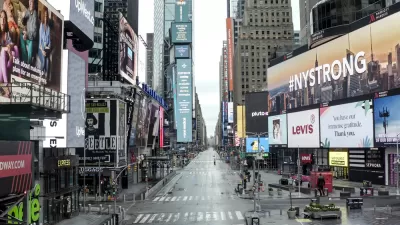Despite some transformative changes and brief spikes in domestic migration, the Covid-19 pandemic seems to be exacerbating existing declines in internal mobility.

A new brief from Riordan Frost of the Joint Center for Housing Studies of Harvard University updates Frost’s prior research on residential migration in the United States, revealing new insights about migration since the start of the pandemic and how it compares to previous trends.
Frost explains that “residential mobility rates have been declining for the past four decades,” and, aside from two spikes in the first year of the pandemic, trends stayed largely the same.
“One finding was that the types of moves and movers that had the steepest mobility rate declines before the pandemic remained the same during the pandemic.” Mobility rates declined across age, race, and ethnicity groups, but households with higher incomes were more likely to move. “Perhaps most notably, rural counties attracted more migrants than usual” as remote work untethered people from cities and high housing costs drove them farther out.
Monthly data allows for more nuanced analysis. “These data reveal that moves spiked twice early in the pandemic before reverting to pre-pandemic levels by the end of 2021 and falling further throughout 2022. As a result, USPS data show all types of moves—individual, family, permanent, and temporary—were lower in 2022 than before the pandemic.” Interestingly, “there were no mobility spikes during later surges like those associated with the Delta and Omicron variants.”
Frost concludes that “The paradigm-shifting nature of the pandemic makes it difficult to assess whether and how mobility patterns will change in coming years, but there are many factors pointing to a continued decline in mobility rates.”
FULL STORY: MOVING DURING THE PANDEMIC: MASS EXODUS OR MASS INERTIA?

Planetizen Federal Action Tracker
A weekly monitor of how Trump’s orders and actions are impacting planners and planning in America.

Maui's Vacation Rental Debate Turns Ugly
Verbal attacks, misinformation campaigns and fistfights plague a high-stakes debate to convert thousands of vacation rentals into long-term housing.

Restaurant Patios Were a Pandemic Win — Why Were They so Hard to Keep?
Social distancing requirements and changes in travel patterns prompted cities to pilot new uses for street and sidewalk space. Then it got complicated.

In California Battle of Housing vs. Environment, Housing Just Won
A new state law significantly limits the power of CEQA, an environmental review law that served as a powerful tool for blocking new development.

Boulder Eliminates Parking Minimums Citywide
Officials estimate the cost of building a single underground parking space at up to $100,000.

Orange County, Florida Adopts Largest US “Sprawl Repair” Code
The ‘Orange Code’ seeks to rectify decades of sprawl-inducing, car-oriented development.
Urban Design for Planners 1: Software Tools
This six-course series explores essential urban design concepts using open source software and equips planners with the tools they need to participate fully in the urban design process.
Planning for Universal Design
Learn the tools for implementing Universal Design in planning regulations.
Heyer Gruel & Associates PA
JM Goldson LLC
Custer County Colorado
City of Camden Redevelopment Agency
City of Astoria
Transportation Research & Education Center (TREC) at Portland State University
Jefferson Parish Government
Camden Redevelopment Agency
City of Claremont





























